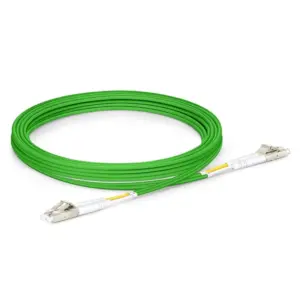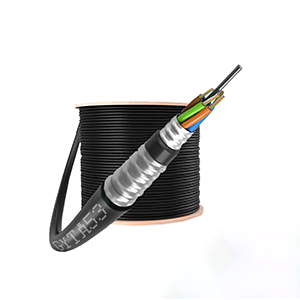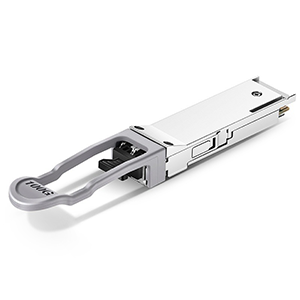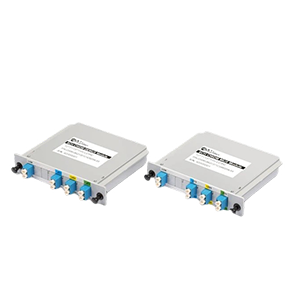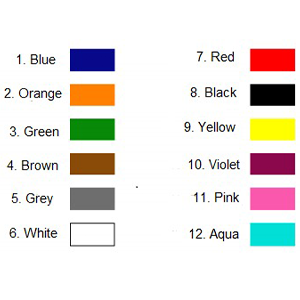I am pleased to introduce you to OM5 fiber optic cable, which is a multimode fiber optic type capable of high bandwidth and high capacity interconnections. In this article, I will introduce the definition, basic principles of OM5 fiber optic cable, as well as its characteristics and advantages in fields such as data center networks and enterprise networks.
OM5 fiber optic cable is a multimode fiber type used for high-speed data transmission and long-distance interconnection. It is based on the working principle of multi-mode optical fiber and realizes data transmission through multiple reflections of optical signals. Compared with single-mode fiber, multi-mode fiber is suitable for short-distance transmission and has higher bandwidth.
Introduction to OM5 optical fiber cable
Definition and rationale:
OM5 fiber optic cable is a multi-mode fiber optic cable used to transmit optical signals. It uses glass cores and cladding structures with different refractive indexes in optical fibers to achieve optical signal transmission.
The basic principle involves the phenomenon of total internal reflection of light. When an optical signal is input from one end of an optical fiber, it reflects back and forth between the fiber core and cladding, traveling along the fiber. The core of an optical fiber is a glass material with a higher refractive index, while the cladding is a lower refractive index material used to limit the propagation of optical signals in the fiber.
Multimode fiber types:
OM5 fiber optic cable is a type of multimode fiber optic cable. Multimode fiber means that optical signals can propagate in multiple modes or paths in the fiber. The OM5 standard is defined in the multimode optical fiber standards developed by TIA (Telecommunications Industry Association) and IEC (International Electrotechnical Commission).
Application fields of OM5 optical fiber cable
Data center network:
OM5 fiber optic cables are widely used in data center networks to support high-speed data transmission and high-capacity interconnection. Here are its applications in data center networks:
-
Server interconnection: High-speed, reliable interconnection is required between servers in the data center. OM5 fiber optic cable can provide high-bandwidth and low-latency connections to meet the needs of fast data transmission between servers.
-
Storage interconnection: Storage devices in the data center need reliable interconnection with servers. OM5 fiber optic cable supports high-speed storage area network (SAN) connections and can meet the transmission needs of large-capacity data.
-
Data center interconnection: Modern data centers usually consist of multiple computer rooms and equipment. OM5 optical fiber cables can be used for interconnection between data centers, supporting high-capacity and long-distance transmission to achieve efficient intercommunication between data centers.
Corporate network:
OM5 fiber optic cables are widely used in enterprise networks to meet high bandwidth requirements and long-distance transmission requirements. Here are its applications in corporate networks:
-
Local Area Network (LAN): OM5 fiber optic cable can be used to establish high-performance local area networks to support fast data exchange and high-bandwidth applications. It is suitable for connecting servers, storage devices and user terminals within the enterprise.
-
Cross-campus networks: Large enterprises and educational institutions often have network equipment distributed across different buildings or campuses. OM5 optical fiber cables can be used to establish cross-campus networks, support long-distance transmission and high-speed connections, and achieve data interoperability between different locations.
-
Video surveillance systems: Enterprise video surveillance systems require high bandwidth and reliable connections. OM5 optical fiber cable can meet the transmission requirements of video surveillance signals and supports high-definition video and real-time monitoring.
-
Remote working: With the popularity of remote working, enterprises need stable and high-speed remote connections. OM5 fiber optic cable can be used in remote office networks, providing fast data transmission and reliable remote connection experience.
In summary, OM5 fiber optic cables are widely used in data center networks and enterprise networks. It can meet high bandwidth requirements, support large-capacity interconnection and long-distance transmission, and provide high-performance and reliable connection solutions for modern networks.
Features and advantages of OM5 optical fiber cable
Transmission rate:
OM5 fiber optic cable supports data transfer speeds up to 100Gbps and higher. Its design and manufacturing enable it to provide high-bandwidth transmission capabilities and adapt to the needs of modern networks for fast data transmission. OM5 fiber optic cables are usually used in conjunction with vertical cavity surface emitting laser (VCSEL) light sources. VCSEL light sources have high-speed transmission capabilities. When combined with OM5 fiber optic cables, high-speed data transmission can be achieved.
Multimode fiber distance:
OM5 fiber optic cable is suitable for short to medium distance transmission needs. According to standard specifications, OM5 fiber optic cable can support multimode transmission over distances, depending on the transmission rate and light source type. The following is the typical distance range of OM5 fiber optic cable at different transmission rates:
-
40/100Gbps transmission rate: At 40Gbps and 100Gbps transmission rates, OM5 optical fiber cable can achieve a maximum transmission distance of 150 meters.
-
25Gbps transmission rate: At 25Gbps transmission rate, the longest transmission distance of OM5 optical fiber cable can reach 300 meters.
It should be noted that the specific transmission distance may be affected by other factors, such as connector quality, fiber attenuation, light source power, etc. Therefore, in practical applications, it is recommended to plan and test fiber optic connections and transmission distances according to specific conditions.
In addition to transmission rate and transmission distance characteristics, OM5 fiber optic cable also has the following advantages:
-
Compatibility: OM5 fiber optic cable is compatible with other multimode fiber optic standards such as OM3 and OM4. This means that OM5 fiber optic cables can be used within existing multimode fiber optic infrastructure without having to replace the entire network equipment.
-
Flexibility: OM5 fiber optic cable is suitable for different application scenarios, including data centers, enterprise networks, and campus networks. It can meet network connectivity requirements of different sizes and needs.
-
Reliability: OM5 fiber optic cable uses high-quality materials and manufacturing processes, and has good anti-interference and durability. It can provide stable and reliable optical signal transmission, reducing the risk of signal loss and interruption.
In short, OM5 optical fiber cable has the characteristics of high transmission rate and is suitable for medium and short distance transmission. Its compatibility, flexibility and reliability make it a widely used choice in modern networks, meeting the needs of high bandwidth and reliable connections.
Structure and construction of OM5 optical fiber cable
Fiber type:
OM5 fiber optic cable uses multimode fiber, the most common type of multimode fiber is 50/125μm. This means that the core diameter of the fiber is 50μm and the cladding diameter is 125μm. In addition, there are 50/200μm multimode fiber types. These fiber types are used in OM5 fiber optic cables to transmit optical signals.
Optical cable housing:
The housing materials and construction of OM5 fiber optic cables are designed to provide protection and mechanical strength. The following are common shell materials and structures of OM5 fiber optic cables:
-
Outer Jacket: The outer jacket of OM5 optical fiber cable is usually made of polymer materials, such as polyvinyl chloride (PVC), low smoke halogen-free (LSZH), etc. The outer sheath has tensile strength and abrasion resistance, protecting the optical fiber from damage from the external environment.
-
Strengthening layer (Strength Member): The strengthening layer in the optical cable provides additional mechanical strength to prevent the optical cable from being affected by tension or distortion during installation and use. Common reinforcing layer materials include fiberglass, fiber reinforced plastic (FRP), etc.
-
Fiber Bundle: OM5 fiber optic cable usually contains multiple optical fibers that are bundled together to form a fiber bundle. Fiber optic bundles can be organized using wrapping, lamination, or filling to provide structural support and protection for the fiber.
-
Fiber Coating: The core and cladding surfaces of optical fibers are usually covered with a coating to protect the core and cladding of optical fibers. Fiber optic coatings are usually made of polymer materials such as acrylic.
Together, these components form the structure of the OM5 fiber optic cable, providing fiber protection, mechanical strength and reliability. The specific fiber optic cable construction may vary depending on the manufacturer and application needs, but the above parts are the common components that make up OM5 fiber optic cable.
OM5 fiber optic cable compatibility and connector types
Compatibility points:
OM5 fiber optic cable has the following points in terms of compatibility:
-
Fiber type compatibility: OM5 fiber optic cable is compatible with other multimode fiber types, such as common OM3 and OM4 fiber. This means that OM5 fiber optic cables can be used within existing multimode fiber optic infrastructure without having to replace the entire network equipment. OM5 fiber optic cables can be interconnected with different types of optical fibers to meet different transmission needs.
-
Equipment compatibility: OM5 fiber optic cable can be compatible with various fiber optic equipment and components, such as fiber optic switches, fiber optic transceivers, fiber optic terminal boxes, etc. It can be connected to devices with corresponding interfaces to realize the transmission and communication of optical signals.
Connector type:
Common connector types for OM5 fiber optic cable include:
-
LC (Lucent Connector): LC connector is a small single-mode and multi-mode fiber optic connector. It uses 1.25mm ceramic or plastic pins, which have a smaller size and are suitable for high-density fiber connections. LC connectors are commonly used in scenarios such as data centers and enterprise networks to provide reliable fiber optic connections.
-
MPO (Multi-Fiber Push-On): MPO connector is a multi-fiber optical fiber connector used to quickly connect multiple optical fibers. It can support different numbers of fiber channels such as 12, 24, 48, etc. MPO connectors are often used in high-density applications, such as fiber optic systems in data centers, to enable quick connection and cabling of large quantities of optical fibers.
In addition to LC and MPO connectors, OM5 fiber optic cables can also use other types of connectors, such as SC, ST, FC, etc., depending on specific application requirements. The choice of connector type often depends on the requirements of the device and network architecture.
It should be noted that in order to ensure the quality and performance of fiber optic connections, the quality and manufacturing process of the connector are very important. High-quality connectors can reduce plugging and unplugging losses, ensure stable optical signal transmission, and provide good mechanical strength and reliability. Therefore, when selecting and using connectors, it is recommended to choose reliable brands and suppliers and follow correct connection and installation steps.
Deployment and installation of OM5 fiber optic cable
Optical cable installation:
-
Optical cable routing planning: Before installing OM5 optical fiber cable, optical cable routing planning needs to be carried out first. Determine the area that needs to be covered, the path and length of the fiber optic cable, and the location of connecting equipment.
-
Preparation: Before installing fiber optic cables, make sure the work area is clean and clear of any obstructions that may cause damage to the fiber optic cables. Check and prepare the required tools, such as fiber optic cable strippers, scissors, cutting tools, etc.
-
Optical cable routing: According to the wiring plan, route the OM5 optical fiber cable along the required path. Make sure the cable is not bent excessively and avoid contact with sharp objects or strong bends.
-
Connector installation: Install the connector at the end of the optical cable as needed. Depending on the type of connector used, follow the connector manufacturer’s instructions for stripping, cleaning, and installing the connector. Ensure proper alignment and retention of connectors.
-
Optical cable protection: After installation, use appropriate protective measures to protect the optical cable, such as optical cable sheath repair tape, protective sleeves, etc. This can increase the mechanical strength and protective capabilities of the optical cable.
Environmental requirements:
The following environmental requirements need to be considered when deploying OM5 fiber optic cables:
-
Temperature range: OM5 fiber optic cable can usually work in a wide temperature range, generally between -40℃ and +70℃. Ensure that the deployment environment temperature of the optical cable is within this range to avoid damage to the optical fiber and connectors.
-
Humidity conditions: The ambient humidity of optical cable deployment needs to be controlled within an appropriate range to prevent humidity from adversely affecting the performance of optical fibers. Typically, the humidity requirements for fiber optic cables range from 0% to 95% relative humidity.
-
Protective measures: In special environments, such as high temperature, high humidity, chemical corrosion, etc., additional protective measures may be required, such as waterproof casings, anti-corrosion coatings, etc., to ensure the reliability and stability of optical cables. .
When deploying OM5 fiber optic cables, it is recommended to follow specific installation guidelines and best practices provided by the manufacturer. In addition, if complex fiber optic cable routing or connector installation is required, it is recommended to seek professional help to ensure that the installation process is correct and reliable.
Advantages and future development of OM5 optical fiber cable
High bandwidth transmission:
OM5 fiber optic cable provides the advantages of high-bandwidth transmission and adapts to the growing network needs. The following are the main advantages of its high-bandwidth transmission:
-
Multi-mode fiber: OM5 fiber is a multi-mode fiber type with a large mode bandwidth, enabling it to support high-speed data transmission. Its design enables it to reduce dispersion and loss during high-speed transmission, providing excellent signal quality.
-
High-speed transmission: OM5 fiber optic cable can support high-speed transmission rates, such as 40Gbps, 100Gbps, 400Gbps, etc. This makes it very useful in data centers, enterprise networks and other high-bandwidth application scenarios to meet the needs of large-scale data transmission and processing.
-
High-density cabling: OM5 fiber optic cable supports high-density cabling and can carry more fiber optic connections in a limited space. This is important for data centers and other environments that require a large number of fiber connections, helping to increase the flexibility and scalability of the network.
Future trends:
OM5 optical fiber cable has broad future development prospects in terms of technology and applications. Here are some future trends:
-
Higher transmission rates: As data demand continues to grow, higher transmission rate requirements will appear in the future. OM5 fiber optic cable will continue to evolve to support higher speed transmission, such as 800Gbps, 1Tbps and even higher rates.
-
Expand to wider application fields: OM5 fiber optic cable will gradually expand to more application fields. In addition to data centers and enterprise networks, it may be widely used in smart cities, Internet of Things, 5G networks and other fields to meet the needs for high-bandwidth transmission in different fields.
-
Further standardization: As the use of OM5 fiber optic cables gradually increases, relevant standards and specifications will be further developed and improved. This will help ensure the interoperability of optical cables and promote the further promotion and application of optical fiber communication technology.
Overall, OM5 optical fiber cable has the advantages of high-bandwidth transmission and has broad future development prospects. As technology advances and application requirements continue to evolve, it will continue to play an important role in the field of high-speed data transmission and communications.
Summarize:
Through this article, you should have a more comprehensive understanding of OM5 fiber optic cables. As a multimode fiber type, OM5 fiber optic cable plays an important role in data center networks and enterprise networks. I hope this article will help you understand OM5 optical fiber cable. If you have any further questions about OM5 optical fiber cable or want to know more information, please continue to pay attention to GracyFiber Company, we will be happy to assist you. Thanks!


